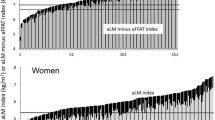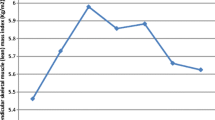Abstract
The purpose of this study was to examine the influence of fat-free adipose tissue mass (FFAT) on association between dual-energy X-ray absorptiometry (DXA)-derived lean soft tissue mass and skeletal muscle mass (TMM). Forty-one middle-aged and older women were recruited for this study. Percent body fat, total and appendicular fat mass (tFM and aFM, respectively), and total and appendicular lean soft tissue mass (tLM and aLM, respectively) were measured using a DXA. FFAT was calculated based on the methods of a previous study. TMM was estimated from the ultrasound-derived prediction equation. The subjects were separated into three groups based on DXA-determined percent fat: low (n = 12, <25 %), middle (n = 15, ≥25 and <35 %), and high (n = 14, ≥35 %). DXA-derived aLM was greater in high than in middle or low, although ultrasound-estimated TMM was similar among the three groups. There was a strong correlation between aLM and TMM (r = 0.905, p < 0.001). The difference between aLM and TMM was correlated (p < 0.001) with aFM (r = 0.599) and tFM (r = 0.587). After adjusting for FFAT, aLM minus appendicular FFAT was similar among the three groups. aLM minus appendicular FFAT was strongly associated with TMM (r = 0.912, p < 0.001). Our results suggest that DXA-derived aLM accurately predicts TMM when subjects have moderate or lower adipose tissue mass. However, FFAT may falsely inflate the DXA-derived aLM measurement in individuals with a relatively high amount of adipose tissue mass (>35 % of body fat). Therefore, in this population, it is advisable to use DXA-derived aLM minus FFAT when evaluating age-related loss of skeletal muscle mass.



Similar content being viewed by others
References
Abe T, Kondo M, Kawakami Y, Fukunaga T (1994) Prediction equations for body composition of Japanese adults by B-mode ultrasound. Am J Hum Biol 6:161–170
Abe T, Kearns CF, Fukunaga T (2003) Sex differences in whole body skeletal muscle mass measured by magnetic resonance imaging and its distribution in young Japanese adults. Br J Sports Med 37:436–440
Abe T, Loenneke JP, Kojima K, Thiebaud RS, Fahs CA, Sekiguchi O (2014a) Influence of strength training on distribution of trunk and appendicular muscle mass. J Aging Res Clin Pract 3:28–30
Abe T, Patterson KM, Stover CD, Geddam DA, Tribby AC, Lajza DG, Young KC (2014b) Site-specific thigh muscle loss as an independent phenomenon for age-related muscle loss in middle-aged and older men and women. Age (Dordr) 36:1353–1358
Baumgartner RN, Koehler KM, Gallagher D, Romero L, Heymsfield SB, Ross R, Garry PJ, Linderman RD (1998) Epidemiology of sarcopenia among the elderly in New Mexico. Am J Epidemiol 147:755–763
Bijlsma AY, Meskers CG, Ling CH, Narici M, Kurrie SE, Cameron ID, Westendorp RG, Maler AB (2013) Defining sarcopenia: the impact of different diagnostic criteria on the prevalence of sarcopenia in a large middle aged cohort. Age (Dordr) 35:871–881
Cruz-Jentoft AJ, Baeyens JP, Bauer JM, Boirie Y, Cederholm T, Landi F, Martin FC, Michel JP, Rolland Y, Schneider SM, Topinkova E, Vandewoude M, Zamboni M, European Working Group on Sarcopenia in Older People (2010) European Working Group on Sarcopenia in Older People. Sarcopenia: European consensus on definition and diagnosis. Age Ageing 39:412–423
Gallagher D, Visser M, De Meersman RE, Sepulveda D, Baumgartner RN, Pierson RN, Harris T, Heymsfield SB (1997) Appendicular skeletal muscle mass: effects of age, gender, and ethnicity. J Appl Physiol 83:229–239
Heymsfield SB, Gallagher D, Kotler DP, Wang Z, Allison DB, Heshka S (2002) Body-size dependence of resting energy expenditure can be attributed to nonenergetic homogeneity of fat-free mass. Am J Physiol Endocrinol Metab 282:E132–E138
Kim J, Wang Z, Heymsfield SB, Baumgartner RN, Gallagher D (2002) Total-body skeletal muscle mass: estimation by a new dual-energy X-ray absorptiometry method. Am J Clin Nutr 76:378–383
Kim J, Shen W, Gallagher D, Jones A Jr, Wang Z, Wang J, Heshka S, Heymsfield SB (2006) Total-body skeletal muscle mass: estimation by dual-energy X-ray absorptiometry in children and adolescents. Am J Clin Nutr 84:1014–1020
Midorikawa T, Yoshitomi A, Sanada K, Abe T (2009) Is the use of ultrasound-derived prediction equations for adults useful for estimating total and regional skeletal muscle mass in Japanese children? Br J Nutr 101:72–78
Pietrobelli A, Formica C, Wang Z, Heymsfield SB (1996) Dual-energy X-ray absorptiometry body composition model: review of physical concepts. Am J Physiol 271:E941–E951
Sanada K, Kearns CF, Midorikawa T, Abe T (2006) Prediction and validation of total and regional skeletal muscle mass by ultrasound in Japanese adults. Eur J Appl Physiol 96:24–31
Conflict of interest
None of the authors had financial or personal conflict of interest with regard to this study.
Author information
Authors and Affiliations
Corresponding author
About this article
Cite this article
Abe, T., Patterson, K.M., Stover, C.D. et al. Influence of adipose tissue mass on DXA-derived lean soft tissue mass in middle-aged and older women. AGE 37, 2 (2015). https://doi.org/10.1007/s11357-014-9741-1
Received:
Accepted:
Published:
DOI: https://doi.org/10.1007/s11357-014-9741-1




